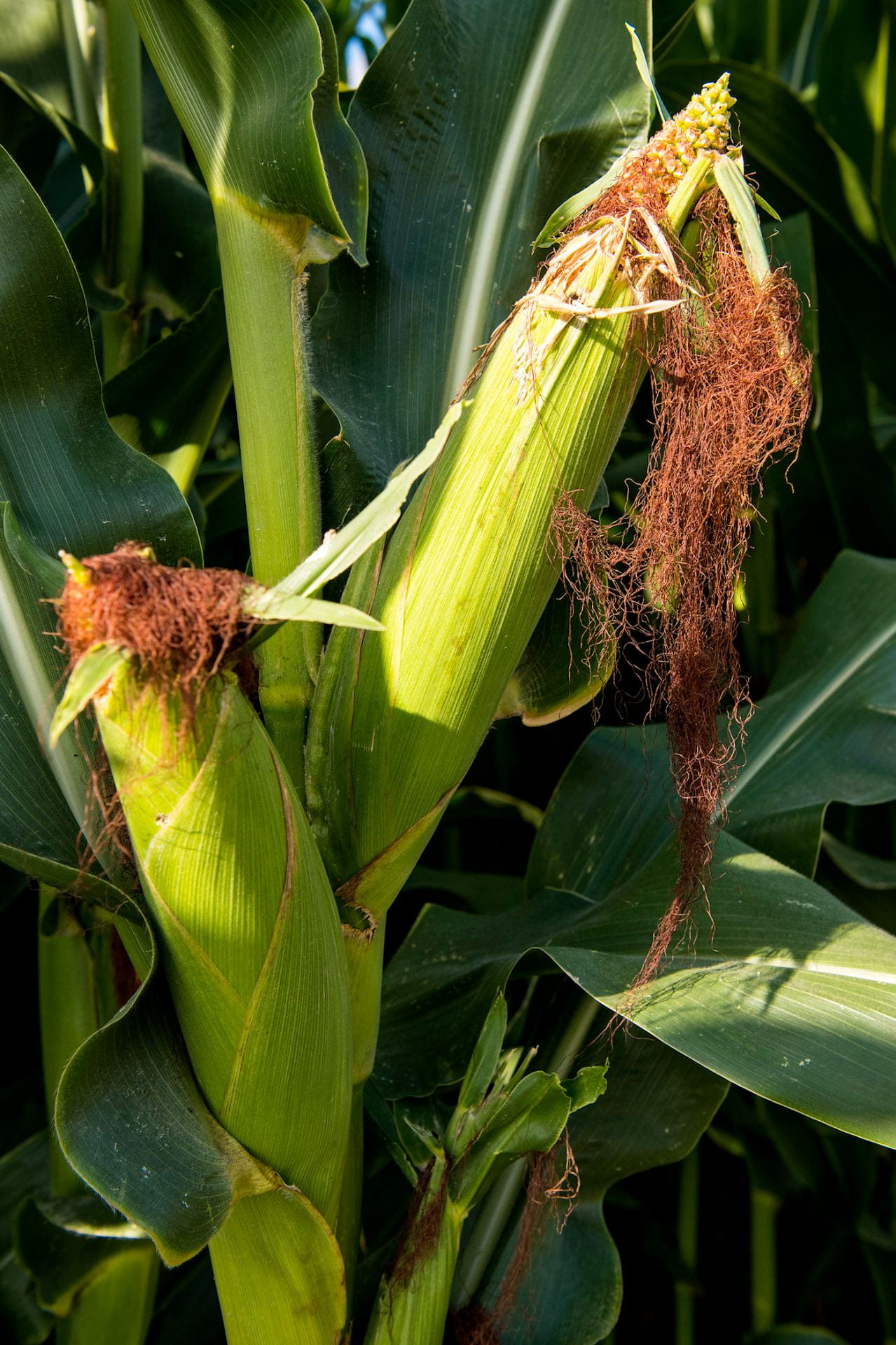YEAREND: Arkansas Pushes Corn through Drought, Rakes in More Winter Wheat Despite Rains
Drought, high temps during pollination period reduced state corn yield 4.3 percent
By John Lovett – Dec. 9, 2022
MEDIA CONTACT
John Lovett
U of A System Division of Agriculture
Arkansas Agricultural Experiment Station
(479) 763-5929 | jlovett@uada.edu
FAYETTEVILLE, Ark. — High temperatures, drought and elevated input costs drove Arkansas corn and grain sorghum production down in 2022, while heavy rains hampered winter wheat.
Jason Kelley, University of Arkansas System Division of Agriculture professor and wheat and feed grains extension agronomist, said the drought and high temperatures hit at a crucial point for corn growers.
“For corn, the pollination period is very critical for the plant to have water, and that lined up right when we were trying to get started on irrigation,” Kelley said. “It was a tough year. Irrigation is effective, but it is never effective as a good, widespread rain.”
Kelley noted that the weather from Memorial Day to July 4th significantly impacts corn yields, and that time was very hot and dry this year. Even though about 95 percent of the state’s corn acres can be irrigated, the drought and heat still took a toll on yields, he said. Farmers struggled to get corn irrigated timely because, in many instances, they were also trying to flood rice and irrigate soybean.
Arkansas farmers harvested 690,000 of the 710,000 acres of corn planted in 2022, according to estimates from the United States Department of Agriculture’s National Agricultural Statistics Service. The number of acres planted was down 16.5 percent from last year. The state average yield was 176 bushels per acre, down 4.3 percent from the prior year’s 183 bushels per acre.
For the past 10 years, Arkansas has averaged 181 bushels per acre. Kelley said that the state’s average yields have increased by 100 bushels per acre in the past 40 years through a combination of better farming practices, more irrigation, improved hybrids and more nutrients.
“On average, we’re gaining about 2.5 bushels per acre a year,” Kelley said. “We’re much better growers now than we were 20, 30, 40 years ago. At the same time, if you took those hybrids we had 40 years ago and planted them this year, the yields would be considerably less than the hybrids we are growing now.”
Kelley said the drought and high temperatures were the two main culprits of the state’s corn yield decrease.
Many farmers also rotate corn with soybeans, which helps improve yields and decrease plant diseases. Kelley said the Arkansas Agricultural Experiment Station’s Lon Man Cotton Research Station in Marianna is wrapping up a 10-year study that shows soybean yields improved by 7 to 8 bushels per acre in a corn-soybean rotation compared to continuous soybean.
Although fuel costs were higher in 2022, fertilizer prices saw an even steeper increase, impacting profit margins. Kelley said fertilizer generally accounts for 30 percent or more of the costs to grow corn because of its high nutrient demand.
“Fertilizer prices hit the corn farmer more than anybody just because of the amount of fertilizer we typically apply,” Kelley said. “The grain price is a pretty good number at around $7 a bushel. Yields were a little down, but if you look at the price, they still should come out OK.”
Kelley said that it was a good harvest for Arkansas corn even though the farmers had to work harder to get their yields because of the drought and higher fuel and fertilizer prices.
Pests and weeds in corn
About 80 percent of the state’s corn crop has Bt varieties developed for enhanced insect protection using naturally occurring bacteria called Bacillus thuringiensis. The bacterial species is harmless to humans and other mammals, but targets caterpillars considered corn pests like corn borers and corn earworms. However, about 15 percent of the state’s corn is considered “conventional” and does not offer the same protection. Kelley said late-planted conventional corn was especially susceptible to corn-borers.
While Palmar amaranth “pigweed” is still controllable in most Arkansas corn fields with atrazine and glyphosate, Kelley said annual ryegrass continues to be a major weed problem for Arkansas corn growers. Ryegrass, which has become resistant to glyphosate and survives Arkansas’ mild winters, gets in the way for many farmers when it is time to plant in March.
“Ryegrass is hard to control in that part of the year, especially in the southern half of the state,” Kelley said. “If you’re trying to kill it in January before planting, it competes very good with corn, so corn planted into a lot of ryegrass is going to struggle.”
Tar spot, which can decrease yields by 20 to 60 bushels per acre in corn, has yet to be reported in Arkansas. However, Kelley said the fungal disease seems to be getting closer each year. Reports indicate the disease has been identified in nearby states, including Kansas, Missouri, Kentucky and several other Midwestern and Southern states.

MEDIA CONTACT
John Lovett
U of A System Division of Agriculture
Arkansas Agricultural Experiment Station
(479) 763-5929 | jlovett@uada.edu
GOLDEN WHEAT — Wheat research plots stand July 8 on the Milo J. Shult Agricultural Research and Extension Center in Fayetteville. (U of A System Division of Ag photo by Fred Miller)
Winter wheat
Arkansas increased its 2022 winter wheat crop by 4.3 percent, planting 220,000 acres last fall. According to NASS, the state attained an average yield of 53 bushels per acre from an estimated 150,000 acres harvested, up 5,000 acres from the 2021 harvest. Kelley said that it may have been more if heavy rains in April and close to harvest time in June and July had not hampered yields and harvested acres.
Kelley added that good grain prices and a relatively dry fall likely encouraged farmers to plant more winter wheat this year for a 2023 harvest. According to the USDA’s Economic Research Service, the 2022/23 season-average farm price is projected at a record $9.20 per bushel. The September farm price reported in the NASS “Agricultural Prices” publication was $8.85, up from $8.55 in the previous month and slightly higher than $7.75 in September 2021.
Early estimates are that winter wheat acres in Arkansas will be up 25 to 30 percent from last year, Kelley said. The final numbers will be available in January.
Grain sorghum
Arkansas planted about 9,000 acres of grain sorghum in 2022. Kelley estimates the average yield for grain sorghum in Arkansas to be around 80 bushels per acre. The grain is used primarily in livestock feed and ethanol production.
“It’s a good crop and there are some producers who like to grow it,” Kelley said. “It does have a good fit on many of our non-irrigated acres and does work well as a rotation crop. But the current problem is with reduced acres being grown, the grain dealers to sell grain sorghum have declined.”
To learn more about the Division of Agriculture research, visit the Arkansas Agricultural Experiment Station website: https://aaes.uada.edu. Follow us on Twitter at @ArkAgResearch and Instagram at @ArkAgResearch.
To learn about Extension Programs in Arkansas, contact your local Cooperative Extension Service agent or visit https://uaex.uada.edu/. Follow us on Twitter at @AR_Extension.
To learn more about the Division of Agriculture, visit https://uada.edu/. Follow us on Twitter at @AgInArk.
About the Division of Agriculture
The University of Arkansas System Division of Agriculture’s mission is to strengthen agriculture, communities, and families by connecting trusted research to the adoption of best practices. Through the Agricultural Experiment Station and the Cooperative Extension Service, the Division of Agriculture conducts research and extension work within the nation’s historic land grant education system.
The Division of Agriculture is one of 20 entities within the University of Arkansas System. It has offices in all 75 counties in Arkansas and faculty on five system campuses.
The University of Arkansas System Division of Agriculture offers all its Extension and Research programs and services without regard to race, color, sex, gender identity, sexual orientation, national origin, religion, age, disability, marital or veteran status, genetic information, or any other legally protected status, and is an Affirmative Action/Equal Opportunity Employer.




